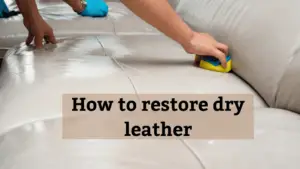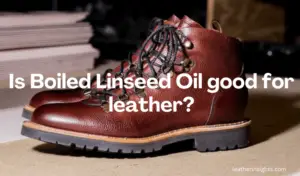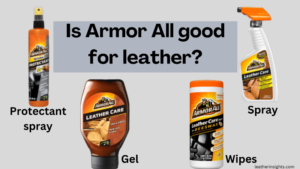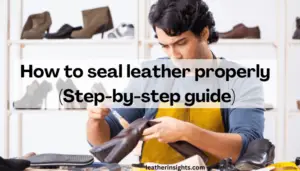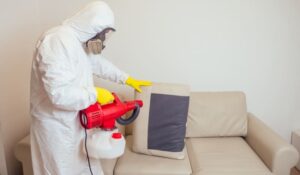How to Fix Leather Jacket Peeling (In 5 WAYS!)
Do you have a beloved leather jacket that has seen better days?
Is the once smooth and supple surface now peeling and cracking making it look worn out and neglected?
It’s frustrating to invest in a quality piece only to watch it deteriorate before your eyes. Luckily, it can be fixed.
In this blog post, we’re going to show you how to fix leather jacket peeling so you can restore it to its former glory.
We’ll also discuss what causes leather jackets to peel and how to stop it from happening.

Why does leather peel or flake?
Below, we look at some of the reasons why your leather tends to peel or flake.
-
Bad quality leather
Peeling leather couches, boots, shoes, or jackets are usually the result of poor-quality leather or poor craftsmanship.
If you are experiencing this with your jacket, it’s likely because the hide wasn’t properly treated during the tanning process.
This can cause the natural oils in the leather to break down, making the jacket more susceptible to drying out and cracking.
The best solution is to take it to a professional for repair. They’ll be able to assess the damage and determine if the jacket can be restored or if you need to buy a new one.
-
Exposure to moisture
Another possibility is that your jacket wasn’t stored in a dry place or it was exposed to too much moisture or water (rain).
If leather is not properly protected against the elements, it can start to rot, deteriorate and peel.
It’s advisable to store your leather clothing in a dry place and avoid exposing it to water.
Using a waterproofing spray can help to protect your leather jacket if you are rained on.
-
Improper cleaning methods
Improper cleaning methods such as abrasive cleaners like magic erasers and harsh chemicals can also tend to cause the leather to peel.
So avoid using harsh chemicals or detergents when cleaning your leather jacket. Instead, use gentle soap and cool water.
You should never put your leather in the dryer rather let it air dry.
Also, avoid getting the leather wet whenever possible. If you do need to clean it with water, make sure to dry it thoroughly afterward.
Lastly, always store your leather jacket in a cool, dry place because heat and humidity can degrade the leather over time.
-
The leather is too dry
Leather can also start to flake if it gets too dry.
This is because leather is skin -animal skin. So just like our own skin, it needs to be properly moisturized in order to stay supple and avoid cracking or peeling.
When leather gets too dry, it becomes brittle and more susceptible to damage.
So if you want your leather jacket to last a long time (and look good doing so), make sure to keep it well-moisturized!
If you live in a dry climate, make sure to condition your jacket more often than normal. Every couple of weeks should keep your jacket well moisturized.
-
The leather is aging
Most leather jackets will last for many years without peeling, but it can happen as the jacket ages.
This usually happens because the leather dries out and becomes brittle over time.
If you happen to have an old leather jacket that’s starting to peel, you might be able to salvage it by moisturizing the leather.
But ultimately, it might be time to retire your old jacket and invest in a new one.
5 ways how to fix leather jacket peeling
Is it possible to repair a peeled leather jacket? Yes, it’s very possible.
However, you’ll want to identify the source of the peeling first. Is it due to wear and tear? Or is it because the jacket got wet and the leather started to separate from the lining?
Once you’ve identified the cause, you can take the following steps to fix the problem.
1. Using a leather filler
Leather fillers come in different colors and textures, so it’s important to choose the right one that matches the color and texture of your leather jacket.
Before using a leather filler, make sure to clean and dry the leather surface thoroughly, so the filler can bond well with the leather.
To fix the peeling, apply a small amount of leather filler to a spatula or putty knife, and spread it over the peeled area, filling in any cracks or holes.
Next, smooth out the surface of the filler and let it dry according to the manufacturer’s instructions.
Once the filler has dried, use fine-grit sandpaper to sand the surface until it’s smooth so that it can blend with the surrounding leather.
2: Using leather paint
You can also fix your leather jacket easily using leather paint.
You can use it to cover up small peeling areas or to touch up larger areas after you’ve used filler or glue.
First, gently sand down the area that is peeling. This will help to smooth out the surface and may even help the jacket look better overall.
Next, apply a thin layer of leather paint to the surface using a small brush or sponge. Try to match the color of the paint as closely as possible to the surrounding leather.
Let the paint dry for 24 hours, and then apply a second coat if necessary.
Once the second coat is dry, buff the painted area with a soft cloth to give it a nice sheen.
3. Using a leather patch
If the peeling area is large or you cannot repair it with filler, you can cover it up with a leather patch.
Cut the patch to the size and shape of the damaged area and glue it in place.
Make sure to apply a thin layer of glue to the edges of the patch to ensure it adheres properly.
Once the glue dries, sand the edges of the patch with fine-grit sandpaper and apply a leather conditioner.
4. Using a permanent marker
If you are looking for an inexpensive way to fix your flaking leather jacket, try using a permanent marker or nail polish.
If you are interested in using a permanent marker, start by start by cleaning the area with an appropriate leather cleaner like saddle soap.
Allow the area to dry completely and then color over the peeled area using a permanent marker in solid strokes.
Let the color dry completely before doing anything else to the jacket.
The good thing about using a permanent marker is that the color doesn’t come off.
5. Nail polish
You can also use nail polish as a temporary fix for small cracks or peels on leather jackets.
You can choose nail polish in a color that matches your jacket as closely as possible or simply pick clear nail polish.
Using the small nail polish brush, apply a thin layer of nail polish over the peeling or cracked area of the leather jacket.
Let the nail polish dry completely before applying another layer if necessary.
How to keep or stop the leather jacket from peeling
Leather jackets can definitely start to peel after a while if they’re not properly cared for.
Luckily, there are a few things you can do to prolong the life of your jacket and prevent peeling.
1. Clean and condition the jacket regularly
Make sure you’re regularly cleaning and conditioning your leather jacket. This will help keep it supple and prevent it from drying out and cracking.
Leather conditioners help to soften and protect the leather and they may be able to help patch up any small tears or cracks.
So, conditioning your jacket will help replenish the natural oils in the hide and make it suppler.
2. Oil the leather jacket
You can also prevent peeling by essentially reintroducing oils back into the leather.
One way to do this is to rub a leather oil such as neatsfoot oil, boiled linseed oil, olive oil, or mink oil into the surface of your leather jacket. This will help replenish some of the lost natural oils and hopefully return your jacket to its former glory.
3. Protect your leather jacket
Exposure to direct sunlight and heat can cause the leather to dry out, which can lead to peeling.
So, when you’re not wearing the jacket, store it in a cool dry place away from direct sunlight and heat sources like radiators or heaters.
You can hang it on a sturdy hanger or store it in a breathable garment bag.
To protect the jacket from UV damage, use a UV protectant spray that is designed for leather. Spray a small amount on the jacket and then use a clean cloth to gently buff it in.
3. Keep jacket away from moisture
Leather is sensitive to moisture and can easily become damaged if it gets wet.
So, avoid wearing the jacket in the rain, and if you do get caught in a downpour, use a clean towel to gently blot away the moisture as soon as possible to prevent water damage to the leather.
Also, consider using a leather waterproofing spray to protect your jacket from moisture.
4. Avoid using harsh chemicals
Harsh chemicals like alcohol or ammonia can damage the leather and cause it to peel.
So, avoid using any harsh chemicals on your jacket including household cleaning products, hairspray, or perfume.
Real leather vs Faux leather jacket, which peels?
Real leather is basically animal skin so if not properly maintained, it will dry out and start to peel. Also, exposure to heat and other environmental factors tends to have a bad effect on the leather.
Faux leather on the other hand is usually made of polyurethane or PVC. Polyurethane faux leather is considered to be high quality and can last for years and years if well maintained. Hence, it does peel easily.
PVC faux leather on the other hand is of lesser quality and tends to peel more quickly especially when exposed to harsh environmental conditions.
To prevent your leather jacket, boots, sofa, or shoes from peeling, make sure to protect them from the harsh weather elements and store them in a cool, dry place when not in use.
Frequently asked questions
-
Does air peel leather?
No, Air itself cannot peel leather. However, exposure to certain environmental factors such as sunlight, heat, and moisture can cause the leather to dry out, crack, and peel over time.
-
Why is my pleather jacket peeling?
Your pleather jacket may be peeling due to wear and tear exposure to heat and sunlight, or poor quality material. Pleather is not as durable as real leather and can start to peel or crack over time, especially with frequent use.
-
Does real leather flake?
Real leather typically does not flake like pleather or faux leather can. However, real leather can still show signs of wear and tear over time, such as cracking or creasing, especially if it is not properly cared for.
Conclusion
There can be a lot of reasons why your leather jacket is peeling.
It could be a defect in the manufacturing process, or it could be that the jacket wasn’t treated properly before you got it and now the protective sealant is wearing off.
If your jacket is made from natural materials like cowhide or sheepskin, then it’s also susceptible to things like weathering and sun damage.
Whatever the reason, if your leather jacket starts to peel it’s important to address the issue as soon as possible so the problem doesn’t get worse.
You can opt for homemade remedies to fix the peeling or bring your jacket to an experienced leather tailor and they’ll be able to restore it.
